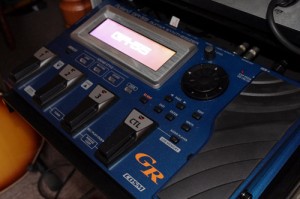Setlist
1 Interference Patterns
2 Mr. Sands
3 Your Time Starts Now
4 Mathematics
5 Lemmings
6 Lifetime
7 Bunsho
8 Over The Hill
9 Scorched Earth
10 Childlike Faith In Childhood’s End
Encore:
11 La Rossa
The last time I’d seen Van der Graaf Generator was back in 2005 when they thundered back to the realm of live performances with their now legendary comeback gig at the Royal Festival Hall. I had tickets for their previous Barbican outing in 2007, but decided not to go because I’d gotten the Missus pregnant and I thought all the noise and excitement of a VDGG concert wouldn’t be conducive to the development of the foetus.
Despite getting a little lost driving into London, we arrived late to miss the first song and caught them blistering through “Mr Sands” from the new album “A Grounding in Numbers”. And quite a bit of material tonight was from this CD and their previous released “Trisector”. But despite this, the one hour and forty-five minute set whizzed past with such speed, such was my enjoyment and involvement with the music.
It takes quite a bit of getting used to not having David Jackson’s saxophones in the mix, but I must admit I didn’t miss him with Hammill covering his lines on guitar and keyboard. This was a very different animal, much leaner, much meaner and definitely louder. The material from “A Grounding in Numbers” felt a lot stronger than the “Trisector” songs, which felt a little meandering and meek in comparison. Of course, you also want some of the old songs and there was a smattering of those to suffice: “Lemmings” which the beginning was almost unrecognisable thanks to Hammill’s lead guitar playing, “Scorched Earth” was dispatched with a raw power you come to expect, but it wasn’t until show closer “Childlike Faith In Childhood’s End” that I felt the power of the music actually suck the air from my lungs and leave me breathless. The encore of “La Rossa” continued to electrify and left me tingling as all the hairs on my neck and body suddenly stood to attention, such was the power of the music.
The band were on good form and one can forgive the “trainwrecks” (Peter Hammill’s words not mine) that happened during the show. The power and brute force of this trio still amazes me and Hammill’s unfaltering voice, which soars and screams and whispers and talks, is worth the ticket price alone. How that man can still do what he does at his age, I find totally awe-inspiring.
I must admit that I had pretty low expectations of the concert, but I feel that was the best place the start because I had a very good evening of music delivered to me. I spent a lot of the evening transfixed by the playing of drummer Guy Evans, who is the heartbeat of the band, while Hugh Banton bolstered the guitar and keyboard playing of Hammill. The only criticism, if there is to be a criticism, is that Peter Hammill is no lead guitarist and his playing was a little weak in places and sometimes you couldn’t even hear him in the mix. But it doesn’t matter because with that voice, Hammill can sing the telephone book and I’d pay to listen.
They are a pretty tight trio when they get going and, despite their collective age, make a lot of younger rock bands look like a bunch of simpering pussies. Viva le VDGG!


![penguin-cafe-a-matter-of-life[1] Penguin Café - A Matter of Life...](http://www.darrenlock.com/wordpress/wp-content/uploads/2011/03/penguin-cafe-a-matter-of-life1-300x263.png)
